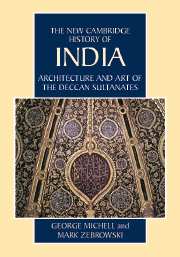Book contents
- Frontmatter
- Introduction
- 1 Historical framework
- 2 Forts and palaces
- 3 Mosques and tombs
- 4 Architectural decoration
- 5 Miniature painting: Ahmadnagar and Bijapur
- 6 Miniature painting: Golconda and other centres
- 7 Textiles, metalwork and stone objects
- 8 Temples
- 9 Conclusion
- Appendix: Dynastic Lists of Deccan Rulers
- Bibliographic Essay
- Bibliography
- Index
- Map of the Southern Deccan"
- Plate Section"
6 - Miniature painting: Golconda and other centres
Published online by Cambridge University Press: 28 March 2008
- Frontmatter
- Introduction
- 1 Historical framework
- 2 Forts and palaces
- 3 Mosques and tombs
- 4 Architectural decoration
- 5 Miniature painting: Ahmadnagar and Bijapur
- 6 Miniature painting: Golconda and other centres
- 7 Textiles, metalwork and stone objects
- 8 Temples
- 9 Conclusion
- Appendix: Dynastic Lists of Deccan Rulers
- Bibliographic Essay
- Bibliography
- Index
- Map of the Southern Deccan"
- Plate Section"
Summary
golconda
Both the character of Golconda painting and the problems involved in reconstructing its history differ considerably from those of other Deccani schools. Neither the austere compositions nor the majestic human figures of Ahmadnagar are present; nor do we encounter the mysterious and romantic world represented in Bijapur art, so far removed from everyday reality. Instead, close ties with Safavid and Mughal art continued throughout the history of the school. Although the Qutb Shahi sultans enjoyed exotic diversity in the paintings they commissioned and employed painters from all over India, Iran and Central Asia – who continued to paint in variants of their original styles – Safavid influence was paramount. This meant that Golconda art was always less humanistic than other Deccani schools: figures are closer to the glorious dolls of Safavid illustration and, therefore, possess less mass and naturalistic expression than is usual in the arts of India.
The Middle Eastern orientation of Golconda painting can be partly explained by the ethnic origins of the ruling house which was descended from the Qara Qoyunlu (Black Sheep) Turkman sultans of western Iran and Anatolia. They were forced to emigrate to India in the fifteenth century and must have continued similar patterns of artistic patronage in the subcontinent, attracting above all Persian artists and writers to their court.
Keywords
- Type
- Chapter
- Information
- Architecture and Art of the Deccan Sultanates , pp. 191 - 225Publisher: Cambridge University PressPrint publication year: 1999



